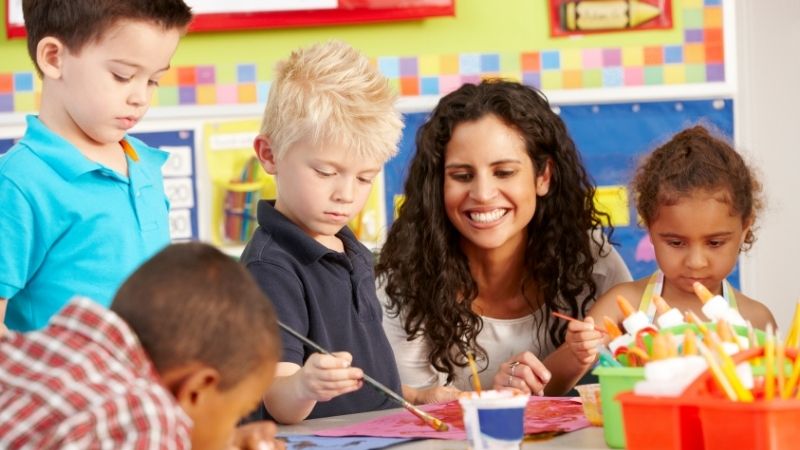
Elementary school curriculum plays a crucial role in shaping the academic foundation of students. It encompasses various subjects such as math, reading, science, history, and art. Mastery of these subjects is essential for a well-rounded education.
This article aims to provide a comprehensive understanding of each subject's importance in elementary school curriculum. By delving into math basics, reading fundamentals, science concepts, history lessons, and art projects, readers will gain insights into the significance of these subjects for a broader academic development.
Key Takeaways
- Math basics form an essential component of the elementary school curriculum, teaching problem-solving skills, logical reasoning abilities, and providing a foundation for advanced math concepts.
- Reading fundamentals, including phonics instruction and reading comprehension strategies, enhance vocabulary, comprehension abilities, and foster creativity and effective communication skills.
- Science concepts in the curriculum encourage curiosity, experimentation, critical thinking, and prepare students for future STEM-related fields.
- History lessons promote cultural awareness, critical thinking, and provide lessons from the past to avoid repeating mistakes, while art projects encourage creativity, self-expression, and boost confidence and self-esteem.
The Fundamentals of Math in Elementary School Curriculum
The fundamentals of math form an essential component of the elementary school curriculum, providing students with a solid foundation in numerical operations and problem-solving skills. Math games are often incorporated into lessons to engage students and enhance their understanding of mathematical concepts. These games not only make learning fun but also encourage critical thinking and logical reasoning.
Problem-solving strategies are taught to help students approach complex mathematical problems systematically. By emphasizing these strategies, students learn how to break down problems into manageable steps, identify relevant information, and apply appropriate problem-solving techniques. This enables them to develop analytical skills that can be applied not only in math but also in various real-life situations.
Overall, the inclusion of math fundamentals in the elementary school curriculum equips students with essential numeracy skills and prepares them for more advanced mathematical concepts in later grades.
Building Strong Reading Skills in Elementary School Curriculum
Building strong reading skills in the elementary school curriculum is crucial for developing well-rounded students. To achieve this, schools must provide effective phonics instruction and implement various reading comprehension strategies.
Phonics instruction: This approach teaches students the relationship between letters and sounds, enabling them to decode words accurately. It focuses on letter recognition, phonemic awareness, and blending sounds together.

Reading comprehension strategies: These techniques help students understand and interpret texts effectively. They include predicting outcomes, making connections to prior knowledge, summarizing information, asking questions, visualizing scenes or characters, and monitoring understanding.
By incorporating these elements into the curriculum, schools can empower students with the foundational skills needed to become proficient readers. Strong reading skills not only facilitate academic success across all subjects but also foster a lifelong love of learning.
Transitioning into exploring exciting science concepts in the elementary school curriculum...
Exploring Exciting Science Concepts in Elementary School Curriculum
Exploring exciting science concepts in the elementary school curriculum involves introducing students to various scientific principles and phenomena. By incorporating hands-on experiments and engaging STEM activities, students are able to actively participate in their own learning experience. These interactive approaches allow students to develop a deeper understanding of scientific concepts while honing their critical thinking skills.
Hands-on experiments provide students with the opportunity to observe, question, and analyze the outcomes of their actions. Through these experiences, they can make connections between theory and practice, fostering a greater appreciation for science. Additionally, STEM activities encourage creativity and innovation as students apply their knowledge to real-world problems.
Uncovering the Richness of History Lessons in Elementary School Curriculum
Uncovering the richness of history lessons in the elementary school curriculum involves immersing students in significant historical events and promoting an understanding of the past. By exploring historical significance and cultural diversity, students gain a broader perspective on global events and develop critical thinking skills. Here are three ways history lessons contribute to a well-rounded education:
Connecting with the Past: History lessons allow students to connect with their roots, understand their heritage, and recognize how past events have shaped the present.

Developing Empathy: Studying history helps students empathize with individuals from different time periods and cultures, fostering respect for diversity and promoting inclusivity.
Enhancing Analytical Skills: Through analyzing primary sources, interpreting historical narratives, and critically evaluating evidence, students develop valuable analytical skills that can be applied across various academic disciplines.
Understanding the richness of history lessons sets a foundation for nurturing creativity through art projects in elementary school curriculum by encouraging students to draw inspiration from different time periods and cultures.
Nurturing Creativity Through Art Projects in Elementary School Curriculum
Promoting creativity through art projects in the elementary school curriculum allows students to express themselves artistically and explore different artistic techniques and mediums. Artistic expression is an essential aspect of education as it fosters imagination, encourages critical thinking, and enhances problem-solving skills.
By engaging in art projects, students can develop their visual perception and spatial awareness, which are crucial for their overall cognitive development. Moreover, art provides a platform for self-reflection and personal growth, allowing students to communicate their thoughts and emotions in a non-verbal manner.
Research has shown that incorporating art into the curriculum positively impacts student engagement, motivation, and academic performance across various subjects. Therefore, integrating art projects into the elementary school curriculum not only cultivates creativity but also enriches the overall learning experience for students.
The Importance of a Well-Rounded Academic Foundation in Elementary School Curriculum
A well-rounded elementary school curriculum is crucial for providing students with a comprehensive educational foundation. It is important to incorporate critical thinking skills and foster social skills within the curriculum to ensure that students are equipped with the necessary tools for success in their academic journey and beyond.

Critical thinking: By including activities that require analysis, evaluation, and problem-solving, students develop their ability to think critically and make informed decisions.
Social skills: Collaborative projects and group discussions provide opportunities for students to interact with their peers, learn effective communication strategies, and develop empathy.
Well-being: A balanced curriculum promotes physical fitness through physical education classes or recess breaks, promoting overall health and well-being.
Frequently Asked Questions
How Can Parents Support Their Child's Math Learning at Home?
Strategies and resources for parents to support their child's math learning at home include creating a structured routine, using educational apps or online programs, incorporating math into everyday activities, providing manipulatives and visual aids, and seeking additional tutoring if needed.
Reading strategies play a vital role in improving reading comprehension among elementary students. Teachers can employ various evidence-based methods, such as explicit instruction, graphic organizers, and questioning techniques, to enhance students' understanding and interpretation of texts.
What Are Some Hands-On Science Experiments That Can Be Done in an Elementary School Classroom?
Hands-on science experiments are a valuable tool for promoting inquiry-based learning in the elementary school classroom. These experiments allow students to actively engage with scientific concepts, fostering a deeper understanding and appreciation for the subject matter.
How Can History Lessons in Elementary School Curriculum Be Made More Engaging for Students?
To make history lessons in elementary school curriculum more engaging, interactive activities such as role-playing games can be implemented. For example, students could reenact historical events, assume the roles of key figures, and actively participate in discussions and debates.

What Are the Benefits of Incorporating Art Projects Into the Elementary School Curriculum?
Incorporating art projects into the elementary school curriculum has several benefits. It enhances creativity, critical thinking, and problem-solving skills. Moreover, it promotes self-expression and improves communication abilities, contributing to a well-rounded academic foundation.
 Careers in EducationElementary EducationHigh School EducationEducational TechnologyTeaching StrategiesSpecial EducationPrivacy PolicyTerms And Conditions
Careers in EducationElementary EducationHigh School EducationEducational TechnologyTeaching StrategiesSpecial EducationPrivacy PolicyTerms And Conditions
